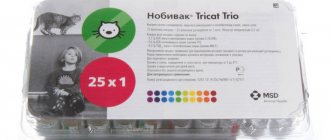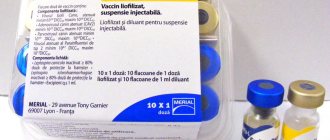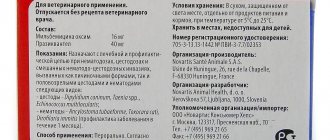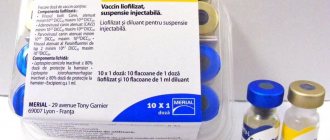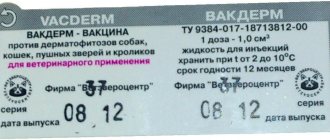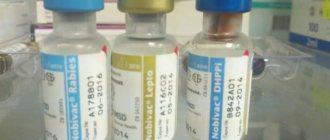A necessary condition for keeping dogs is their timely vaccination. This is a procedure for artificially infecting an animal with a weakened virus in order to develop immunity to a particular disease. Having received the vaccination, if your pet comes into contact with an infected dog, it will either not get sick or suffer a mild form of the disease.
Today, there are both monovalent (against one type of virus) and polyvalent (against several types of viruses) vaccines. The standard vaccination schedule includes vaccination against hemorrhagic (parvovirus) enteritis, leptospirosis, viral hepatitis, rabies and canine distemper.
How much does a distemper vaccination cost? Vaccines designed to prevent multiple diseases are more expensive. Thus, the price of the Russian monovalent vaccine against canine distemper “Cardanone” is about 150 rubles, the polyvalent French drug “Eurican” is from 350 rubles.
Why are dogs vaccinated against distemper?
Vaccination solves several important problems:
- it protects the pet from a dangerous disease - carnivorous plague;
- supports immunity by reducing morbidity;
- prevents the likely spread of the distemper virus in the canine population.
Most diseases included in the list of mandatory immunizations are fatal. By vaccinating, you protect your pet from danger. It must be taken into account that even if an animal that becomes infected with distemper survives, it suffers complications. They will affect his health throughout his life. Therefore, vaccination is a reliable protection for the dog against complications and chronic illnesses.
If you go on a trip with a pet, then to cross the border you need to have all the vaccinations. A must-have way to protect the animals at your final destination from the exchange of dangerous viruses between dogs. And this is also a very important reason for vaccination.
Important! Plague is resistant to any weather conditions. This means that it can infect animals all year round.
Veterinary passport
An international veterinary passport is the most important document for a dog, without which long trips with a dog around the country, travel abroad, participation in exhibitions and breeding are impossible.
The most important points of a dog’s veterinary passport are:
- vaccination against rabies and other infectious animal diseases;
- flea and tick treatment;
- deworming;
- reproduction.
The document also contains information about the owner of the animal, identification (in the case of implantation of an electronic chip) and some characteristics of the dog, in particular gender, color and special features.
How do vaccinations work?
Vaccines contain the same microorganisms that cause disease. Accordingly, the distemper vaccine contains the canine distemper virus, but in a weakened form. It is not enough to make the dog sick. But it is enough to force the immune system to produce antibodies that can destroy the virus.
The presence of these antibodies in the blood is immunity. This means that if the plague virus enters the body, it will be destroyed immediately by existing antibodies. Therefore, vaccination is the most effective means of preventing disease.
Vaccination against distemper is used between 4 and 12 weeks of age. Immunity develops within 72 hours after injection. The drug is administered in the amount of 1 dose.
Biology of the pathogen and epidemiological data
The causative agent of canine plague is an RNA virus belonging to the genus Morbilliviruses (family of Paramyxoviruses). This group also includes human measles viruses and rinderpest viruses. There are two viral proteins H and F on the surface of the chemical compound.
Protein H (hemagglutinin) with a molecular weight of 76 kDa performs the function of attachment to the so-called target cell. The protein has good variability, making it easily attached to different tissues.
The F (fusion) protein with a molecular weight of 62 kDa is responsible for the fusion of the affected cell and the virus, as well as the further spread of infected cells in the body.
It is noteworthy that the virus is resistant to external factors, especially in dried or frozen form. In this form, it can be active for 3-4 months. But if the environment is heated to 56°, then within 1.5 hours it will die. At 37-40°, the elimination of the virus occurs after 15 days. A 1% formaldehyde solution helps get rid of it in just 3 hours. A 2% NaOH solution can kill the disease in just 1 hour.
What types of vaccines are there?
There are 4 main types of vaccines:
- live weakened;
- inactivated;
- subunit, recombinant, polysaccharide and conjugate;
- colloidal.
The first consist of a weakened microorganism. They are similar to a natural infection and therefore create a long-lasting protective effect. But they have limitations:
- they should not be injected into patients with weakened immune systems;
- cannot be given to animals after surgery.
This group of drugs must be stored under special conditions before use, otherwise the contents of the bottle will change and you will not get the expected effect.
Did you know? Vaccination was first invented in India and China. People were vaccinated against smallpox by rubbing scabs from an infected person into a cut on the arm.
The second group is “killed” microorganisms that cause disease. They are not as strong as the first ones, so they are injected in several stages in order to ultimately develop immunity.
The third group is fragments of a microorganism (not a whole virus) that causes the disease. They will provide strong immunity and, most importantly, they can be injected into all groups of patients.
The fourth group contains a toxin produced by a microorganism. It will create immunity to the germ parts of the pathogen. This means that immunity will develop from the toxin, and not from the microorganism itself. An example of such a drug is the tetanus vaccine in humans.
The contents of one bottle can only be directed against one disease. This vaccine is called monovalent. And if it contains a drug against several diseases, then it is a polyvalent vaccine.
It is very easy to understand which one to use. If there are 3-5 pathogens of various diseases in a bottle, then an adult dog can cope with them quite easily. But for a puppy’s unformed immune system this is difficult. And the veterinarian may recommend purchasing monovalent vaccines to vaccinate against each disease separately and make it easier for the puppy to process them.
The most common vaccine against distemper is Nobivak. It was developed in 1969 by a Norwegian company. It is complex and is used for several diseases at once. To understand how many of these diseases are and what they are, look at the abbreviation of English letters next to the name. These are abbreviations for the names of diseases whose pathogens are in the bottle. For Nobivak this is DHPPI, which stands for as follows:
- D = distemper virus (canine distemper);
- H = hepatitis;
- P = parvovirus;
- P = parainfluenza;
- I = enteritis.
Important! If a dog is infected with distemper and survives, then its contact with other animals is prohibited for another month, since it is a carrier of the disease and can infect others.
Costs 1 bottle (1 dose) - 264 rubles. The vaccine sold for puppies is Puppi DP. It is intended for the formation of immunity against plague and parvovirus enteritis. The cost of the bottle is 302 rubles. You can also purchase other types of Nobivak vaccines:
- DHP - against plague, hepatitis and parvovirus at a price of 181 rubles;
- Lepto - against leptospirosis at a price of 76 rubles.
The vaccine is a dry powder. To give an injection, you need a bottle with the active substance and a bottle with a solvent. The cost of the solvent for Nobivak is 48 rubles.
If you need to be vaccinated against a disease that is not included in the Nobivak complex, then carefully read its abbreviation so as not to vaccinate your pet twice against the same diseases. The only exception is rabies. This vaccination is recommended to be done separately from others.
Other vaccines against plague:
| Vaccine | Features of application | Price |
| "Biovac" | The contents of the vial are the live component of the virus. Therefore, puppies can only be injected with it from 8 weeks of age. Give 2 vaccinations with an interval of 14 days. On the label next to the name there is a letter indicating the name of the disease. "Biovac-D" creates immunity against canine plague. | 199 rub. for 1 bottle |
| "Hexadog" | Forms immunity against plague, parvovirus, adenovirus, rabies, leptospirosis. The vaccination is given subcutaneously, once, 12 weeks after the puppy is born. Vaccination of sick animals is prohibited. 10 weeks before use, you need to treat your dog for worms. | 445 rub. |
| "Eurikan DHPPI2 - L" | It acts against the entire range of diseases - plague, parvovirus, adenovirus, parainfluenza, leptospirosis. Allowed from 7 weeks of age. It is administered subcutaneously, twice with an interval of 3–5 weeks. | 577 rub. |
| "Multikan" | It exists in several versions: “Multican-4”, and . In the first case, the vaccine works against distemper, parvovirus, adenovirus and coronovirus. In the second, leptospirosis is added to the set, and in the third, rabies will be added. The drug can be administered to a healthy animal that has been given an anthelmintic 2 weeks before vaccination. Do it twice, with an interval of 1 month. Can be used for puppies over 8 months old. | 217 rub. |
| "Duramun Max 5-CvK/4L" | Works against the entire set of diseases except rabies. Puppies can be vaccinated starting at 6 weeks. To be vaccinated, the animal must be completely healthy. | 400 rub. |
When should dogs be vaccinated against distemper?
Vaccinations can begin when the puppy is 6–9 weeks old. These numbers should be understood as follows:
- if the probability of infection is quite high, then the puppy is vaccinated earlier, at 6 weeks;
- and if the probability of getting sick is low, then you can do it later - on the 9th.
Did you know? The virus that causes canine distemper can infect Amur tigers.
The second important parameter is the type of vaccine. It is not recommended to vaccinate puppies with live viruses. Therefore, a drug made from killed plague viruses or virus fragments is used for them. Then 2 vaccinations are given:
- the first at 6–9 weeks;
- the second 10–18 weeks after the first.
But you need to take into account that there is a list of a number of diseases against which your puppy needs to be vaccinated. There should be at least 10–14 days between injections. Therefore, the veterinarian suggests a vaccination schedule. In order to do everything right, it is better to use his recommendations.
Revaccination is prescribed when the dog turns 1 year old. And then the vaccination is updated annually for an adult animal
Features for different breeds
There are no differences in the use of vaccines for different breeds. All other parameters, gender or weight, also do not matter. The vaccinated animal must be healthy. And he must be 6, 8 or more weeks old. The manufacturer indicates such information in the indications for use.
You also need to consider the contraindications section. Most often, there are prohibitions for pregnant or lactating bitches, as well as for patients with tails, after drugs that were used to treat them for worms.
Important! Vaccination does not prevent the disease virus from entering the pet’s body. But dogs that have never been vaccinated, older dogs and puppies are more likely to contract distemper than vaccinated animals.
Rules for vaccination against plague
Each of the diseases that are part of the vaccine, including distemper, is very dangerous. And if the drug contains living but weakened microorganisms, then in order for them to continue to remain so, the temperature regime must be observed. Vaccines from the manufacturer to the distribution center (pharmacy or veterinary clinic) must be delivered in special containers equipped with thermal sensors. Stored under special conditions until vaccination.
If the drug is not contained correctly, it becomes ineffective, at best. At worst, he will be dangerous. Therefore, you have the right to decide that you can get vaccinated yourself. But when choosing a place of purchase, be sure to make sure that the vaccine was stored correctly and that it came into your hands directly from a special refrigerator. If you are not sure about this, then buy it elsewhere or contact a veterinarian.
Preparing the dog
You need to know for sure that the vaccination is being given to a healthy animal. Visually this is not always noticeable. For example, the disease may be in a latent phase of development. To make sure your pet is healthy, undergo a full veterinary examination. This can be confirmed by laboratory tests of urine, blood and stool.
As for worms, not all parasites can be detected in the samples submitted for analysis. Therefore, be sure to treat your dog for them. This can be any drug:
- “Pyrantel” at a dosage of 5–10 mg per 1 kg of pet’s body weight;
- “Milbemax” - 0.5 tablets are required for 1 kg of a puppy, and 1 tablet for a pet weighing from 1 to 5 kg, etc.
The dose of the drug depends on the weight of the dog. And most of them do not affect worm eggs. Therefore, manufacturers recommend deworming in 2 stages with an interval of 10 days. This must be taken into account when planning your vaccination date.
Important! Do not use a vaccine whose expiration date has expired.
Step-by-step instructions for administering the vaccine
The vaccine is presented in the form of 2 bottles. One contains a dry active substance, and the other contains a solvent.
To inject yourself against canine distemper, you must adhere to the following rules:
- Wear gloves.
- Heat the liquid component in your hand to the dog’s body temperature, i.e. +38°C.
- Pour the contents of the heated bottle with a syringe into the first one with the dry vaccine, and shake so that there is no sediment left. The solution should then be used within 10–15 minutes.
- Inject the injection intramuscularly into the thigh area. The place where the injection is given can be on the inside of the thigh or on the outside. The tissue in such a place is rich in blood vessels, so the medicine is absorbed faster.
- When choosing a location, be careful not to hit the sciatic nerve. It is located in the middle of the leg.
- The injection site is usually not treated. An antiseptic always deactivates living microorganisms.
- The angle of inclination in order to hit the muscle should be about 90°. 15–25° is a subcutaneous injection. The number of milliliters should correspond to the manufacturer's instructions.
- Bottles containing such dangerous pathogens should be boiled for 5 minutes before being thrown into the trash.
Preparing for vaccination
Only healthy animals are allowed to be vaccinated. Before vaccination, a specialist conducts a comprehensive examination of the dog’s condition. The examination includes measuring body temperature and drawing blood for analysis. And only after the veterinarian is convinced that there are no contraindications, immunization is performed.
Vaccination is not carried out during the change of teeth. The vaccination is given either before or after the complete replacement of baby teeth.
A recent infection is also a contraindication. In this case, immunization is postponed to another time, when the four-legged friend is completely healthy.
Read The essence of arthrodesis on the joints of a dog: indications, complications and reviews
Two weeks before vaccination, the animal must be dewormed. For this purpose, special anthelmintics are used in tablets; there are also emulsions for puppies and adults, which can be purchased at a veterinary pharmacy, clinic, or pet store in any city. At the same time, dogs are treated against ectoparasites with insecticidal and acaricidal agents (for example, Bars Forte, Dana, Advocate).
How to care for your dog after vaccination
Some dogs develop mild lethargy in response to the vaccine. They may feel unwell for 1-2 days. A small lump will form at the injection site. In a couple of days, all of the above symptoms should end. If your dog does not feel better or you notice that the lump is getting bigger and hurting, you should contact your veterinarian.
After vaccination, the dog must be quarantined for 14 days. This is done so that the puppy does not become infected at this time with the disease for which it was vaccinated. In addition, at the moment when immunity against distemper is formed, the pet will be weakened and more easily infected with other diseases.
Variants of the course of the disease
To date, 4 forms of distemper in dogs have been identified:
- lightning;
- apathetic;
- acute;
- chronic.
Each option has its own set of symptoms. Let's look at them to be savvy in any situation.
1. Lightning fast
This type of disease is perhaps the most elusive. Outwardly, the dog practically does not betray its condition. She can be active, playful, sociable. As a rule, with this course of the disease, only a refusal to eat is observed, but in most cases the owners do not have time to focus on this. Within a few days after infection, the animal dies. Sudden death is often attributed to cardiac arrest. The true cause can only be revealed through detailed research.
2. Apathetic
Another hidden form of plague. However, unlike the fulminant type, in this form the disease can last up to several months. For example, a dog may begin to limp, but this will go away within a day or two. Other symptoms appear and disappear, dulling the owner’s vigilance. As a result, the already advanced disease enters the lightning stage, and the animal suddenly dies.
3. Spicy
This is the so-called classic Carré disease. In this case, all the symptoms are visible and appear in combination. If the owner acts correctly, there is every chance of saving the pet.
4. Chronic
Unlike the apathetic form, all symptoms are present, but they are expressed implicitly. If you are attentive to your pet, you can detect the disease, but often the disease clearly manifests itself at the last stage and develops into an acute form.
